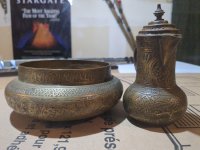Joecoins
Hero Member
Hello and thank you for your help.
Purchased this recently on eBay.
From an American seller, who sells mostly high quality asian stuff .
He called it a 1900 Persian bowl
No further info, he had it listed without all the figural images shown. And even upside down photos to lead. It was most affordable compared to his other stuff.
With currency exchange and shipping and even duties this did cost me a little..
It had some mystery and looked cool compared to others...
My main questions are what kind of script?
Can it be translated?
what culture ,what styles ? What era/ age. Whats depicted? And any further info.
There is 12 images on the bowl






Purchased this recently on eBay.
From an American seller, who sells mostly high quality asian stuff .
He called it a 1900 Persian bowl
No further info, he had it listed without all the figural images shown. And even upside down photos to lead. It was most affordable compared to his other stuff.
With currency exchange and shipping and even duties this did cost me a little..
It had some mystery and looked cool compared to others...
My main questions are what kind of script?
Can it be translated?
what culture ,what styles ? What era/ age. Whats depicted? And any further info.
There is 12 images on the bowl








